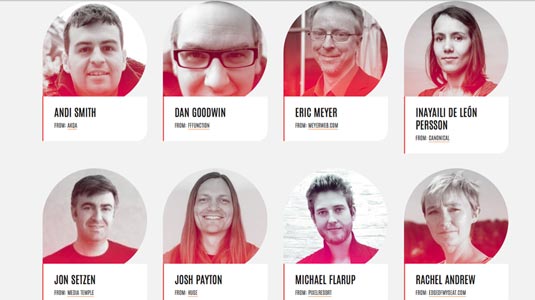Eric Meyer on the past, present and future of CSS
To understand the future of CSS, you first need to understand its past. And standards guru Eric Meyer has been there right from the start.
The year was 1996. "I was the webmaster for a university in Cleveland," he recalls. "I was in Paris to present a paper at the fifth international World Wide Web Conference, and there was a presentation on Cascading Style Sheets. Chris Wilson gave a demo and the top of my head blew off. I was like, this is the greatest thing ever."
But he soon fell down to earth with a bump. "At that moment I didn't realise how bad browser support was," he admits.
See Eric Meyer speak about how to design for a crisis at Generate London 2015 – buy your ticket today!
"When I got back to the office I started trying to use CSS and discovered that things didn't do what I thought they should." But he soon recovered his optimism.
"IE3 had a partial implementation and I figured they'd fill in the rest of the holes. And Netscape would get up to speed. And everything would be fine. I didn't realise what lay ahead."

For a time the very survival of CSS was in doubt. "Between 1998 and 2000 there were so many problems with browser implementation it looked like CSS might never take off.
Daily design news, reviews, how-tos and more, as picked by the editors.
"But I just kept pushing on it. It was only when DOCTYPE switching came in that I regained my confidence and enthusiasm."
It was during this period that Meyer 'accidentally' became one of the world's leading advocates for CSS and web standards.
Uncharted waters
"I started building test pages for myself," he recalls. "Then I joined a public mailing list, www-style, and sent mail to Chris Lilley, who was then chair of the CSS Working Group, saying: 'Hey, I threw together these test pages, I don't know if you'd be interested in them', not realising that there was nothing else quite like it in existence.

He said: 'Would you mind if I shared these with the browser makers?' I said: 'Sure, go ahead.'" Those pages eventually become the core of the CSS1 test suite at the W3C. "I just didn't realise how uncharted the waters were, I guess."
"Since I was running browsers through these pages to see what worked, I started putting together support charts and publishing them, and one thing led to another.
Titanic struggle
I was asked to write monthly articles for Web Review, and from there got the opportunity to write books, including Cascading Style Sheets: The Definitive Guide, CSS 2.0 Programmer's Reference and Eric Meyer on CSS.
The turn of the century saw a titanic struggle to make CSS mainstream, he remembers. "We had to convince authors and browser makers that converging on the same standards and implementing them as consistently as possible was actually the right thing to do.
"In the late 1990s and early 2000s, standards projects faced a lot of pushback – from authors more than anybody else. They'd say: 'What we have works, and you're never going to get browser makers to work together, and this is just a pipe dream.'

"But people like Jeffrey Zeldman, Tim Bray, Jeff Veen, Glenn Davis and the other founders of the Web Standards Project just kept pushing straight ahead.
"There were a few of us who supported them: the CSS Samurai as we were called, the CSS Action Committee, which was headed up by John Allsopp. It was not a battle with a certain outcome.
"I personally didn't see any other sensible outcome, of course – but as anyone who's studied history is aware, the sensible outcome is not always the one you get."
Future challenges
Fast-forward to now: and the landscape has completely changed, with the majority of web designers favouring standards and all mainstream browsers supporting large swathes of CSS3. So has the battle been won?
"The hard job is done," says Meyer. "Though we're still obviously having problems with inconsistencies between browsers." But that's a problem Meyer thinks we're always going to have.

"Browsers are always going to go at different speeds," he points out. "And even if they went at the same speed, there would always be inconsistencies. It would be bugs if nothing else."
While some see fragmentation as only a bad thing, Meyer sees the upside too. "The only way you can have a web where every browser acts the same is where there's only one browser," he argues.
Strength through diversity
"You always have to deal with the inconsistencies because it's not a monoculture, which can be frustrating. But it's also a great strength, because the browser makers have each other to look at and play off of.
"Then there's a discussion about: 'Is this worth doing for everyone, or is just the one browser going to have it?' And if it's worth doing but maybe not worth doing that way, then maybe there'll be a new spec that will describe this behaviour but with a different syntax.
"I think that's healthy. It can be frustrating as an author that this shiny thing that you want right now isn't there right now. You might have to wait a little while, or a few years. But you know, we get there."
Responsive first
The current battle, says Meyer, is responsive design. "It's like 10 years ago we said: 'You start with standards and then you add proprietary stuff as needed.' I feel kind of the same way about this movement.
"Responsive design is really awesome, and I think it will become even better as we get better tools. As those become supported, they'll make responsive design so much easier and more powerful.

"I'd recommend to everyone to start on the assumption that you'll use responsive design – and only if you then decide it's inappropriate should you not do it."
Constant evolution
CSS is continually evolving and new properties are emerging all the time. While some are worried about using new properties that may not be fully supported, Meyer urges designers to throw caution to the wind and start experimenting.
"I was writing about CSS in the late 1990s and half of every article was: 'Okay, so now that I've explained how this is supposed to work … the two browsers do this totally differently and here's how you work around that.' And people would occasionally say: 'Why did you write an article about something I can't use?'
"But most of the time it was: 'Oh that sounds awesome, I can't wait!' And I think the same is true of CSS3 today, and will continue with CSS4 and beyond."
This article first appeared in issue 224 of net magazine.
See Eric speak at Generate London: buy your ticket today!

Tom May is an award-winning journalist specialising in art, design, photography and technology. His latest book, The 50 Greatest Designers (Arcturus Publishing), was published this June. He's also author of Great TED Talks: Creativity (Pavilion Books). Tom was previously editor of Professional Photography magazine, associate editor at Creative Bloq, and deputy editor at net magazine.
